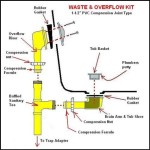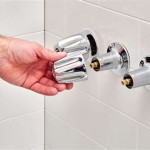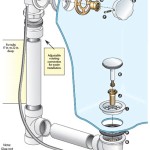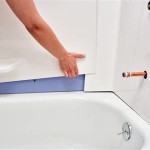Choosing the Right Sealant for Bathtub Spout Diverter Valve Replacement
Replacing a bathtub spout diverter valve is a common plumbing task that requires careful consideration of the materials used, particularly the sealant. The sealant's role is to create a watertight barrier between the spout and the water supply pipe, preventing leaks and protecting the surrounding structure from water damage. Selecting the appropriate sealant is crucial for the longevity and effectiveness of the repair. Several types of sealants are available, each with its own advantages and disadvantages. Understanding these characteristics allows for an informed decision, ensuring a secure and reliable seal.
The purpose of this article is to provide a comprehensive guide to selecting the correct sealant for a bathtub spout diverter valve replacement. It explores various sealant types, their properties, and their suitability for this specific plumbing application. Factors such as water resistance, temperature tolerance, and ease of application are considered. By understanding these aspects, individuals can confidently choose the optimal sealant for their needs, resulting in a durable and leak-free repair.
Key Considerations When Selecting a Sealant
When selecting a sealant for a bathtub spout diverter valve replacement, several key factors must be taken into account. These factors relate to the environment the sealant will be exposed to, the materials it will be bonding to, and the ease with which it can be applied.
First and foremost is water resistance. The bathroom environment is consistently exposed to moisture, and the sealant will be in direct contact with water. Therefore, the sealant must be completely waterproof to prevent leaks and potential water damage to surrounding walls and flooring. A sealant that degrades or softens when exposed to water is unsuitable for this application.
Temperature tolerance is another critical aspect. Hot water is regularly used in bathtubs, and the sealant must be able to withstand these temperature fluctuations without losing its integrity. Sealants that become brittle or crack under high temperatures will compromise the seal and lead to leaks. The sealant's temperature rating should be clearly indicated on the product packaging, and it should exceed the maximum temperature of water typically used in a bathtub.
The material compatibility of the sealant with both the spout and the water supply pipe is also crucial. Different materials expand and contract at different rates, and the sealant must be able to accommodate these movements without separating from the surfaces it is bonding to. Sealants designed for specific materials, such as metal or plastic, should be chosen accordingly.
Finally, ease of application is a practical consideration. Some sealants are easier to apply than others, and this can impact the quality of the seal. Factors such as viscosity, curing time, and the need for specialized tools should be considered. Sealants that are easy to apply and tool will generally result in a more uniform and reliable seal.
Types of Sealants Commonly Used
Several types of sealants are commonly used in plumbing applications, each possessing unique properties that make them suitable for different tasks. For a bathtub spout diverter valve replacement, the following sealant types are frequently considered:
Plumber's putty is a soft, pliable compound that is primarily used to create a watertight seal around drains and faucets. It is easy to apply and mold into the desired shape, but it does not cure or harden. While plumber's putty can be used in conjunction with other sealants, it is not typically recommended as the sole sealant for a bathtub spout diverter valve due to its limited water resistance and temperature tolerance. Over time, it can dry out and crack, leading to leaks.
Pipe joint compound, also known as pipe dope or thread sealant, is a paste-like substance that is applied to threaded pipe joints to create a watertight seal. It typically contains materials such as Teflon or PTFE, which provide lubrication and help to fill any imperfections in the threads. Pipe joint compound is effective at preventing leaks in threaded connections, but it is not suitable for sealing non-threaded surfaces. Therefore, it is not the primary choice for sealing the main contact point between the spout and the pipe.
Silicone sealant is a versatile and widely used sealant that offers excellent water resistance, temperature tolerance, and adhesion to a variety of materials. It is available in a range of formulations, including those specifically designed for plumbing applications. Silicone sealant cures to form a flexible, rubbery seal that can withstand movement and vibration. It is generally considered a good choice for sealing a bathtub spout diverter valve, but it is important to select a high-quality, 100% silicone sealant that is specifically labeled for plumbing use.
Latex caulk is another option, though generally less preferred than silicone for plumbing applications. While it is paintable and easy to clean up, latex caulk is not as waterproof or durable as silicone. It is more prone to shrinking and cracking over time, making it a less reliable choice for sealing a bathtub spout diverter valve. If latex caulk is used, it should be a high-quality, water-resistant formulation.
Thread seal tape, also known as Teflon tape, is a thin, white tape that is wrapped around threaded pipe fittings to create a watertight seal. While effective for threaded connections, it is not suitable for sealing the main contact point between the spout and the pipe, as it does not provide a strong adhesive bond. Thread seal tape is typically used in conjunction with pipe joint compound to enhance the seal on threaded connections.
Step-by-Step Guide to Applying Sealant
Proper application of the sealant is just as important as choosing the right type. The following step-by-step guide outlines the recommended procedure for applying sealant when replacing a bathtub spout diverter valve:
1.
Preparation:
Begin by thoroughly cleaning the surfaces to which the sealant will be applied. This includes the end of the water supply pipe and the inside of the bathtub spout. Remove any old sealant, debris, or corrosion. Use a wire brush or sandpaper to roughen the surfaces slightly, which will improve adhesion. Wipe the surfaces clean with a solvent such as isopropyl alcohol to remove any remaining grease or oil. Allow the surfaces to dry completely before applying the sealant.2.
Applying the Sealant:
Apply a bead of sealant around the end of the water supply pipe, where the spout will make contact. The bead should be thick enough to fill any gaps or imperfections in the surfaces, but not so thick that it will squeeze out excessively when the spout is installed. Follow the manufacturer's instructions for the specific sealant being used. Some sealants require a specific drying time before assembly.3.
Installing the Spout:
Carefully slide the bathtub spout onto the water supply pipe, ensuring that it is properly aligned. Push the spout firmly into place, compressing the sealant and creating a watertight seal. Avoid twisting or rocking the spout, as this can disrupt the sealant and create voids.4.
Removing Excess Sealant:
Once the spout is in place, carefully remove any excess sealant that has squeezed out around the edges. Use a putty knife or damp cloth to wipe away the excess, creating a clean and professional finish. Avoid using sharp objects that could damage the sealant or the surrounding surfaces.5.
Curing Time:
Allow the sealant to cure completely according to the manufacturer's instructions. This may take several hours or even overnight, depending on the type of sealant used. Avoid using the bathtub during the curing process to allow the sealant to fully set and create a strong, watertight seal.6.
Testing for Leaks:
After the sealant has cured, test for leaks by running water through the bathtub spout. Carefully inspect the area around the spout for any signs of water leakage. If any leaks are detected, tighten the spout or apply additional sealant as needed. It is important to address any leaks promptly to prevent water damage.Choosing the correct sealant and applying it properly are essential steps in replacing a bathtub spout diverter valve. By carefully considering the factors discussed in this article and following the recommended procedures, individuals can ensure a durable and leak-free repair.

How To Install Red Disc Seal Protect Your Bathtub Wall Prevent Drywall Damage Www Reddiscseal Com

Danco Tub Spout Diverter Repair Kit 89205 The Home Depot

Bathtub Spout With Diverter Replacement Fix Leaking Tub Jonny Diy

Everbilt Tub Spout Diverter Repair Kit 865320 The Home Depot

How To Fix A Shower Diverter Repair Or Replace

How To Fix A Failed Tub Spout Seal Diy Friendly Task

How To Seal Tub Spout And Valve Trim With Silicone Caulking The Fixer Clips

How To Install A Tub Spout The Home Depot

Diverter Spout Gate Repair Kit

Water Not Coming Out Of Shower Head Tub Spout Diverter Repair
Related Posts








